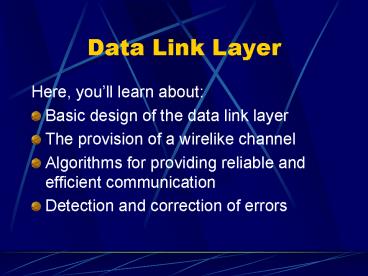Data Link Layer - PowerPoint PPT Presentation
1 / 20
Title:
Data Link Layer
Description:
Data Link Layer. Two sublayers: The Media Access Control (MAC) The Logical Link Control (LLC) ... layer coding violations - applicable only to networks in which ... – PowerPoint PPT presentation
Number of Views:231
Avg rating:3.0/5.0
Title: Data Link Layer
1
Data Link Layer
- Here, youll learn about
- Basic design of the data link layer
- The provision of a wirelike channel
- Algorithms for providing reliable and efficient
communication - Detection and correction of errors
2
Data Link Layer
- Two sublayers
- The Media Access Control (MAC)
- The Logical Link Control (LLC)
3
Data Link Layer Issues
- Providing a well-defined service interface to the
network layer - Determining how the bits of the physical layer
are grouped into frames - Dealing with transmission errors
- Regulating the flow of frames so that slow
receivers are not swamped by fast senders
4
Services Provided to the Network Layer
- The principal service is transferring data from
the network layer on the source machine to the
network layer on the destination machine. - Three different service levels
- unacknowledged connectionless service
- acknowledged connectionless service
- acknowledged connection-oriented service
5
Framing
6
Framing
- Different framing methods for networks
- Character count
- Starting and ending characters, with character
stuffing - Starting and ending flags, with bit stuffing
- Physical layer coding violations
7
Framing
- Character Stuffing
- Bit Stuffing
8
Framing
- Physical layer coding violations - applicable
only to networks in which encoding on the
physical medium contains some redundancy
9
Error Control
- Making sure all frames are eventually delivered
to the network layer at the destination, and in
the proper order - Positive and negative acknowledgements
- Timing mechanisms
- Handling multiple sending of frames
10
Flow Control
- Managing fast senders for slow receivers
- You may send me n frames now, but after they
have been sent, do net send any more until I have
told you to continue.
11
Error Detection and Correction
- Error occur in both wired and wireless
communication - Wireless communication is becoming more common
- Error rates of wireless communication are orders
of magnitude worse than wired communication
12
Error Correcting Codes
13
Error Correcting Codes
- Introduction of redundancy to allow the receiver
to deduce that an error occurred and what the
transmitted character must have been - Use exclusive-or (XOR) to determine how many bits
differ
14
Hamming Code
- Hamming distance the number of bit positions in
which two codewords differ - To correct d errors, you need a distance of 2d1
code because that way the legal codewords are so
far apart than even with d changes, the original
codeword is still closer than any other codeword,
so it can be uniquely determined
15
Hamming Code
- Example of an error-correcting code with only
four valid codewords - 0000000000, 0000011111,
- 1111100000, and 1111111111
- Code has a distance of 5
- Code can correct 2 errors
16
Parity Bit
- Given the message is 100101, what is the parity
bit of this message? - Even Parity if the number of set (1) bit is even
(parity bit is 0) - Odd Parity if the number of set (1) bit is odd
(parity bit is 1)
17
Error Detecting Codes
18
Error Detecting Codes
- Only include enough redundancy to allow the
receiver to deduce that an error has occurred,
but which error, and have it request an
retransmission - Requires less bits to detect errors compared to
Hamming code (error correcting code) - To detect d errors, you need a Hamming distance
of d1
19
Error Detecting Codes
- Convert the message to a matrix of bits to detect
long error bursts - Polynomial code or Cyclic redundancy code (CRC)
20
CRC
- Polynomial Arithmetic
21
CRC
22
CRC
- Polynomials used in International Standards for
CRC - CRC-12 X12 X11 X3 X2 X1 1
- For character length of 6 bits
- CRC-16 X16 X15 X2 1
- For character length of 8 bits
- CRC-CCITT X16 X12 X5 1
- For character length of 8 bits































